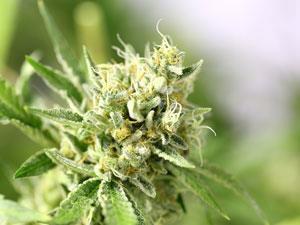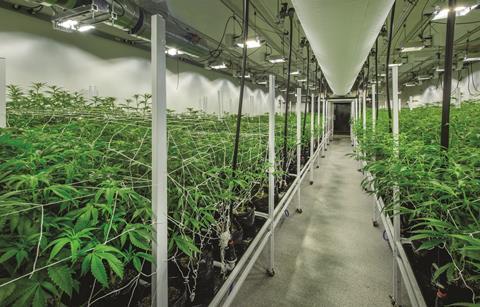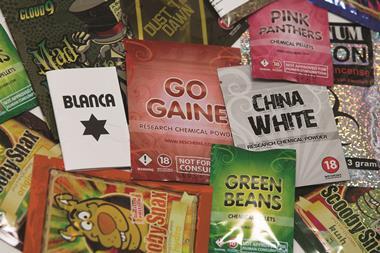Meera Senthilingam
This week, we're on a high. Here's Akshat Rathi.
Akshat Rathi
Today I am going to talk to you about a sacred molecule. It is found in what the Hindus once called the 'food of gods' or as we know it today, cannabis.
Tetrahydrocannabinol or THC, as it is abbreviated, is the psychoactive substance in cannabis which is also known as weed, marijuana, ganja, hash, pot, mary jane or the various other names that people have given it. Although the first known use of cannabis goes back about 5000 years, this molecule was isolated and characterised only in 1964.

Cannabis is a genus of flowering plants that contain THC, are native to central and southern Asia, and find their first reference in the Hindu Vedas in 1500BC. And yet, cannabis as a euphoriant finds mention in Roman literature only in AD160 and its widespread use in northern Europe, surprisingly, did not begin until the 1780s.
THC's effects come from binding to the cannabinoid receptors – CB1 in the central nervous system and CB2 in the immune system. Partial activation of CB1 leads to its psychoactive effects. These receptors are involved in a range of physiological functions, from memory retention to blood pressure, controlled by endocannabinoids. Strangely, though, these naturally occurring signalling molecules, endocannabinoids bear relatively little structural resemblance to THC. They are mostly derivatives of arachidonic acid - a long chain polyunsaturated fatty acid, whereas THC is an aromatic terpenoid containing three rings.
People who have used any of the derivatives of cannabis have been exposed to its multiple effects, one of which is appetite stimulation - better known as the munchies. Its other effects may be best described by German pharmacologist Louis Lewin who was one of the first to classify drugs according to their effects, and described them as 'an exhibition of gaiety in which smokers behave in a very childish and stupid manner, in a dream-like state where all the thoughts which pass through the brain are lightened by the sun..and.the bonds of time and space are broken'.
But how harmful is THC really?
THC itself has very low toxicity. Earlier in this podcast series we heard that it takes only 50mg of nicotine to kill someone. If you want to use THC to do that job, you would need 300 times as much. It is estimated that to achieve fatal concentrations of THC, one may have to smoke around 680kg of cannabis in under 15 minutes. Little wonder there are no documented human fatalities from a THC overdose.
To study the effects on humans, the inmates of a US prison were given marijuana in 1944. The researchers concluded that marijuana is not a drug of addiction when compared to morphine, and if tolerance is acquired, it is of a very limited degree. Furthermore, those who have been smoking marijuana for a period of years showed no mental or physical deterioration that could be attributed to the drug.
THC itself does have medical uses. It has shown anti-proliferative activity to certain types of brain tumour and prostate cancer cells. Synthetic THC - called dronabinol - and its analogue nabilone have been used for many years in the US and Canada to treat vomiting and nausea induced by cancer chemotherapy.
When taken in conjunction with other drugs, cannabis has been shown to alleviate some symptoms of multiple sclerosis and arthritis, which led the British Medical Association to recommend legalisation of cannabis in 1997.

However, courts in the UK and the US have proven unsympathetic, even when the governments of Netherlands, Canada and New South Wales in Australia have relaxed their rules governing cultivation of cannabis for personal medical use. Part of the reason for this is the multitude of other compounds present in cannabis smoke, some of which could be harmful. Another reason is the large amount of cannabis you would need to smoke to get a therapeutic effect rather than just a 'high'.
But that hasn't stopped companies from trying to develop medicines based on pure THC. Sativex, a mouth spray produced by GW Pharmaceuticals, has been approved Canada since 2005 and was approved in several European countries earlier this year. It contains THC and cannabidiol to help alleviate symptoms of multiple sclerosis.
Whichever way the legalisation debate goes, if you don't have a chance to legally try marijuana, maybe these words by French poet Charles Baudelaire will give you all that experience. 'External objects have monstrous appearances. Sounds have a color, colors have music, musical notes are numbers, and you solve with frightening rapidity prodigious arithmetic problems. In this supreme condition, love is in the tender minds and the most singular artistic forms.'
Meera Senthilingam
That's certainly one insight into the recreational effects of THC. That was Chemistry World's Akshat Rathi, with the psychoactive yet medicinal chemistry of tetrahydrocannabinol. Now, next week, the origins of keeping clean.
Brian Clegg
Back with those Ancient Egyptians and Babylonians we see the first significant use of sodium hydroxide. They discovered, presumably accidentally when trying to wash away ash, that water that run through vegetable ashes took on a specific property. It changed oil or fat into something different, something that would become known as soap. The process was remarkable in itself, because it took a substance that wouldn't dissolve in water and made it soluble - but more so with the (presumably again accidental) discovery that this new product helped get things clean.
Meera Senthilingam
And to find out more about the history of sodium hydroxide, as well as its many other industrial uses, join Brian Clegg in next week's Chemistry in its element. Until then, thank you for listening. I'm Meera Senthilingam.













No comments yet